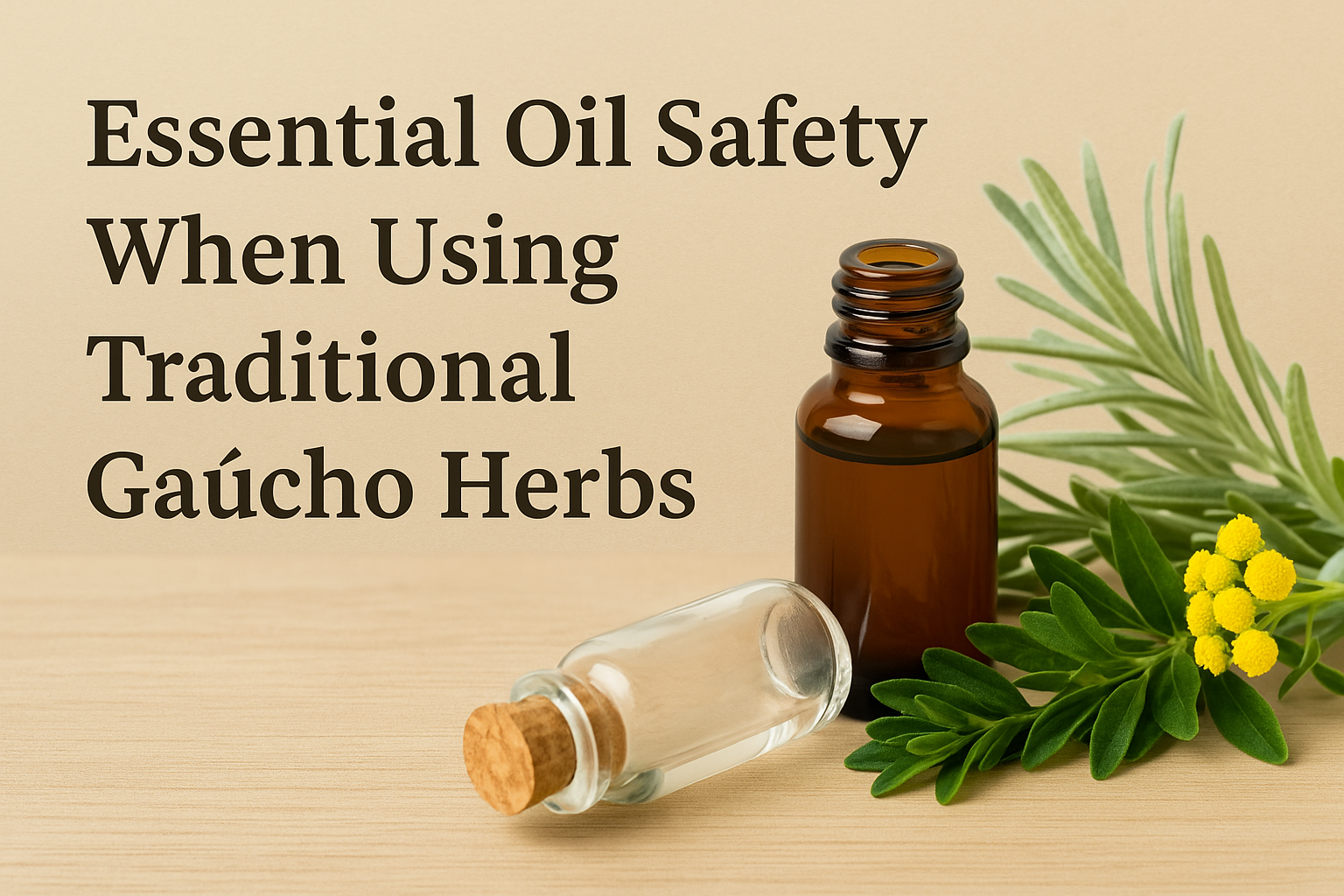The herbal traditions of Rio Grande do Sul carry centuries of knowledge about how to use local plants like Marcela, Carqueja, Boldinho, Mint, and Erva-doce.
Today, these same herbs are being rediscovered and transformed into essential oils — concentrated forms that offer powerful healing when used correctly.
But with this potency comes responsibility. Essential oils are much stronger than traditional teas or infusions, and knowing how to use them safely — especially when working with native Gaúcho herbs — is essential.
This guide will help you understand how to enjoy the benefits of traditional oils while protecting your health and honoring the plants.
Why Essential Oil Safety Matters
Essential oils are powerful because they contain the concentrated essence of a plant. Just a few drops can have strong physical and emotional effects.
However, misuse can lead to:
- Skin irritation or burns
- Allergic reactions
- Hormonal disruption
- Respiratory problems
- Toxicity when ingested or overused
In Gaúcho culture, herbs were used with care, respect, and intention — and we must continue that legacy when working with their oils.
Common Misconceptions About Essential Oils
“Natural means safe.”
Not always. Many natural substances are toxic in high doses. Essential oils are not the same as herbal teas — they’re highly concentrated.
“If a little works, more is better.”
Wrong. With essential oils, less is often more. Overuse can damage your skin, liver, or nervous system.
“I can ingest oils if they’re pure.”
Never ingest essential oils unless under the care of a qualified aromatherapist or doctor — especially with strong herbs like Carqueja and Boldinho.
Understanding the Oils of Gaúcho Herbs
1. Carqueja (Baccharis trimera)
Properties: Detoxifying, bitter, stimulant
Cautions:
- Can cause skin sensitivity
- Should not be used during pregnancy
- May affect liver in high concentrations
- Strong — always dilute heavily
2. Boldinho (Peumus boldus)
Properties: Liver tonic, grounding, digestive
Cautions:
- Contains alkaloids that may be toxic in large doses
- Avoid in children, pregnant or breastfeeding women
- Not recommended for ingestion
- May interact with medications
3. Marcela (Achyrocline satureioides)
Properties: Calming, anti-inflammatory, antispasmodic
Cautions:
- Generally safe topically in low doses
- Can cause drowsiness — avoid using before driving
- Not for use on infants without dilution
4. Mint (Mentha spp.)
Properties: Cooling, stimulating, clears airways
Cautions:
- Avoid around eyes and mucous membranes
- Not suitable for infants or very young children
- Can reduce milk production in breastfeeding women
- Do not apply directly to skin without dilution
5. Erva-doce (Fennel)
Properties: Balancing, antispasmodic, hormonal support
Cautions:
- Contains phytoestrogens — avoid in hormone-sensitive conditions
- Not for use during pregnancy without supervision
- May cause skin sensitization in some people
Safe Dilution Guidelines
Essential oils must always be diluted in a carrier oil before applying to the skin.
Adult Dilution Rates
- 1% = 6 drops per 30 ml (gentle, for daily use)
- 2% = 12 drops per 30 ml (typical for massage)
- 3% = 18 drops per 30 ml (short-term therapeutic use)
Children and Elderly
- Use 0.25% to 0.5% dilution (1 to 3 drops per 30 ml)
Pregnancy
- Avoid oils like Carqueja and Boldinho
- Use gentle oils (Marcela, Lavender, Citrus) with professional guidance
Safe Application Methods
1. Topical Use (Skin)
Always dilute in a carrier oil:
- Jojoba
- Sweet Almond
- Grapeseed
- Olive
- Coconut
Never apply undiluted essential oils directly to the skin.
2. Aromatic Use (Inhalation)
Use in a diffuser (3–6 drops per session) or apply to a personal inhaler.
Avoid excessive exposure — 30 minutes at a time is enough.
3. Bath Use
Mix oils first with:
- 1 tbsp carrier oil
- Or 1 tbsp full-fat milk
- Then add to water
Do not drop oils directly into bath water without dilution — they float and may burn skin.
Oils to Avoid Internally
None of the traditional Gaúcho herb oils should be taken by mouth without supervision. This includes:
- Carqueja
- Boldinho
- Mint
- Fennel
- Rosemary
Even when oils are labeled “therapeutic grade” — that doesn’t mean they’re safe to ingest.
Patch Testing for Safety
Before using a new oil:
- Mix 1 drop of essential oil with 1 tsp carrier oil
- Apply to inside of forearm
- Wait 24 hours
If redness, itching, or swelling occurs, avoid that oil.
Essential Oil Use in Children
Most Gaúcho oils are too strong for children under 6 years old. Use with caution and guidance.
Safe practices:
- Diffuse oils in well-ventilated rooms
- Use hydrosols (plant waters) instead of oils
- Apply only diluted oils to soles of feet, never face
Avoid mint, rosemary, and fennel with infants unless advised by a pediatric aromatherapist.
Essential Oils and Pets
If you live with animals (especially cats and dogs):
- Avoid diffusing strong oils like mint or rosemary for long periods
- Never apply essential oils to your pet without veterinary approval
- Keep essential oils stored securely away from animals
Pregnancy and Breastfeeding
Avoid the following traditional oils during pregnancy:
- Carqueja
- Boldinho
- Rosemary (in high doses)
- Mint (in first trimester)
Marcela and Erva-doce may be used under supervision in low doses.
Always consult a professional if unsure.
Photosensitivity: Sun and Citrus Oils
Some oils, when applied to the skin, can increase sunburn risk.
Citrus oils like lemon or orange (often blended with Gaúcho herbs) are phototoxic.
Avoid sun exposure for 12–24 hours after using these oils on your skin.
How to Store Your Oils Safely
- In dark glass bottles
- Away from heat and sunlight
- Out of reach of children and pets
- Tightly sealed to prevent oxidation
Shelf life varies:
- Mint and citrus: 1–2 years
- Rosemary, boldo, fennel: up to 3 years
- Marcela (if available): up to 2 years
Signs of Overuse or Sensitivity
If you experience any of these, stop using the oil immediately:
- Headaches
- Nausea
- Skin irritation or rashes
- Dizziness
- Shortness of breath
These are signs that your body may be reacting poorly — even to natural substances.
Integrating Traditional Oils With Modern Safety
Honor Gaúcho tradition by:
- Using native oils with respect
- Learning their effects and limits
- Combining old wisdom with current research
- Teaching others safe and intentional use
Your ancestors used herbs with deep intuition. Today, we can deepen that care with science and responsibility.
Final Safety Checklist Before You Blend
✅ Is the oil appropriate for your age and condition?
✅ Is it well diluted?
✅ Have you patch tested it?
✅ Do you understand any contraindications?
✅ Is the oil fresh and properly stored?
✅ Are you using it with clear purpose?
Final Thoughts: Wisdom and Respect Go Hand in Hand
The herbs of the southern land are sacred. Their transformation into essential oils gives us powerful tools for healing, ritual, and well-being — but only if we use them with intention and care.
When you blend with Carqueja, Boldinho, or Mint, you are channeling the strength of generations. Let your hands and heart carry that knowledge forward, not with fear — but with clarity, respect, and reverence.
Let tradition meet safety. Let power meet responsibility. And may your practice honor both your health and your heritage.

Marcela Cardozo is passionate about Southern Brazilian traditions and the cultural stories carried through natural scents. She blends knowledge of native herbs, essential oils, and regional rituals to create practical and inspiring content. Her writing connects ancestral wisdom with modern living, offering readers simple ways to bring authenticity, well-being, and meaning into their everyday lives.
